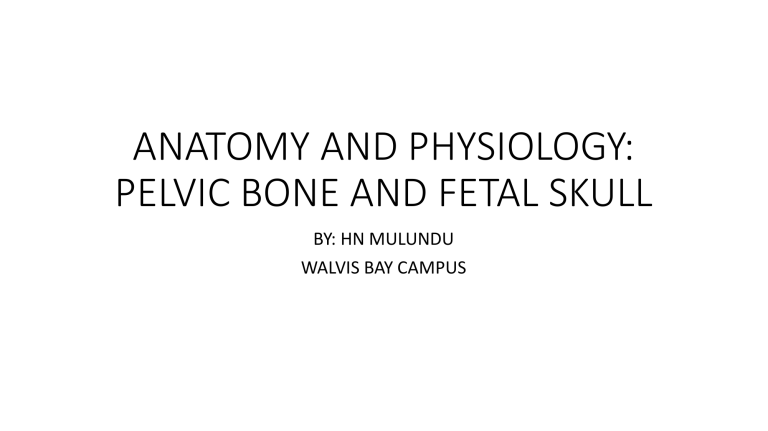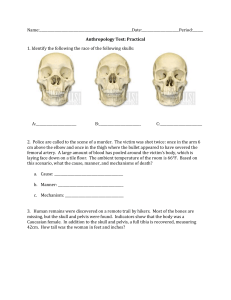
ANATOMY AND PHYSIOLOGY: PELVIC BONE AND FETAL SKULL BY: HN MULUNDU WALVIS BAY CAMPUS OBJECTIVES At the end of the session, student should be able to: Outline the structures of the pelvis Mention the bones of the pelvis Explain the joints of the pelvis Explain the ligaments of the pelvis Describe the muscles of the pelvic floor Discuss the types of pelvis and their effects on labour Describe the areas or zones of the true/gynaecoid pelvis Explain the landmarks of the pelvis. identify and plain different types of pelves INTRODUCTION The bones of pelvis is combine to form the pelvic canal, were the fetus pass during birth. The shape and size of pelvic bones determines whether the fetus of the average size will pass in it. The gynaecoid pelvis is the normal female shaped pelvis that is suitable for a normal child birth Four bony structure of pelvis two innominate bones sacrum the coccyx THE INNOMINATE BONES the ilium The ischium pubic bone THE ILIUM Is the strongest heavy superior bone the upper part of ilium forms the false pelvis the posterior joins to the ala of the sacrum at sacroiliac joint. upper curved boarder is know as iliac crest. the iliac crest ends posteriorly in the posteriorsuperior iliac spine THE ILIUM And anteriorly in the anterior – superior iliac spine. the lower portion of the ilium forms the part of the Of the ischium posteriorly and the pubic bone anteriorly. the upper and lower portion of the ilium forms a ridge which divides the false and true pelvis. true pelvis, which meets the inferior boarder the rigde is named the iliopectineal line. the iliopectineal line forms the lateral border of the pelvic brim or inlet of the true pelvic cavity. THE ISCHIUM Lower part of innominate bone. the thicker lower boarder is the ischial tuberosity. the body mass is taken on by these bones. these bones form the part of pelvic outlet. the thin inferior ramus projects forward and upwards from, that joins with the inferior of the pubic THE ISCHIUM Bones, to form an arc. superiorly the ischium widen and joins the ilium, in the posterior portion of the acetabulum. PUBIC BONE consist of two arms. superior and inferior rami. The body of two pubic bone meet inferiorly to form symphysis pubis. upper and superior ramus form pubic crest. The two arms meet the ischium inferiorly and ilium superiorly, which forms the oval window. Or hole in inferior pelvic wall, known as obturator foramen. THE SACRUM Strong and heavy bone. Forms posterior part of pelvis. articulate on both sides with ilium at the sacroiliac joint. made up of five fused vertebrae. PELVIC JOINTS Sacroiliac joint Between sacrum and ilium Strongest joint in the body Sacrococcygeal joint Sacrum and coccyx Enable coccyx to bend backward allowing fetal head to negotiate the outlet of pelvis canal. PELVIC JOINTs Lumbosacral joint lies posterior aspect of pelvis between 5th lumbar vertebrae and sacrum PELVIC LIGAMENTS Ligaments are fibrous strong connective tissues, the ligaments of the pelvis strengthen or connects the joints of the pelvis. They are partially cartilaginous, Or partially fibrous Sacrospinous ligament Sacrotuberous ligament SACROSPINOUS LIGAMENTS is from lower sacrum and coccyx towards ischial spines. it surrounds the lower boarder of sciatic notch. it is covered by coccygeus muscle of a pelvic floor. SACROSPINOUS CONTINOUES… SACROTUBEROUS LIGAMENT It covers the lesser sciatic notch and runs from lower sacrum coccyx to the ischial tuberosity. TRUE PELVIS True pelvis is crucial in obstetrics, because is were the fetus pass during delivery. It is divided into 3 areas/ zones. PELVIC ZONES pelvic brim or inlet pelvic cavity/ mid-pelvis pelvic outlet TRUE PELVIS CONTINUES…. PELVIC INLET/BRIM significant area zone, since it must adequate for the fetal head to pass through, if not labour becomes obstructed engagement of the fetal head Takes place if the fetal head goes through the pelvic brim. PELVIC BRIM CONTINUES LAND MARKS OF PELVIC BRIM posteriorly: promontory of the sacrum, the alae of the sacrum and sacro- iliac joints. laterally: illio-pectineal lines, and ilio-pectineal eminences. anteriorly: pubic crest and symphysis pubis MEASUREMENT OF PELVIC BRIM MEASUREMENTS OF PELVIC BRIM CONTINUES…… ANTERO- POSTERIOR DIAMETERS. obstric conjugate of 11 cm. - Measured from central sacral promontory to posterior symphysis pubis the anatomical or true conjugate of 12cm. - From central tip sacral promontory to the summit of symphysis pubis MEASUREMENTS OF PELVIC BRIM CONTINUES…. the diagonal conjugate of 12cm. - Can be assessed during vaginal examination. - from tip of promontory of sacrum to bottom of symphysis pubis. MEASUREMENTS OF THE PELVIC BRIM CONTINUES OBLIQUE DIAMETERS. all oblique diameters of pelvic brim measure 12cm. from left or right sacro-iliac joint to pectineal eminence. TRANSVERSE DIAMETERS transverse diameter of pelvic brim measure 13cm. - Measured from the widest part of pelvic brim MEASUREMENT OF PELVIC BRIM CONTINEUS…. the sacro- cotyloid dimension measures 9,5cm - Measured from central sacral promontory to the ilio- pectineal eminence. PELVIC CAVITY/ MIDPELVIS Area between inlet and outlet of the pelvis. LAND MARKS Anterior wall: formed by pubic bones and it’s depth is 4 cm. posterior wall: formed by curve of sacrum, length is 12cm. lateral wall: covered by obturator Internus muscles and sciatic notch. MEASUREMENT OF PELVIC CAVITY MEASUMENTS OF PELVIC CAVITY ANTERO- POSTERIOR, OBLIQUE AND TRANSVERSE DIAMETERS. All measurements of the pelvic cavity are 12cm ISCHICIAL BI-SPINOUS MEASUREMENT. Is only 10 cm to 10.5 cm. measured between ischial spines. PELVIC OUTLET Is the lower circumference of the true pelvis. it is described in terms of anatomical and obstetrical outlet. LAND MARKS POSTERIORLY: coccyx and sacro-tuberous ligaments. LATERALLY: ischial tuberosities. ANTERIORLY: the pubic arch. MEASUREMENT OF PELVIC OUTLET MEASUREMENTS OF PELVIC OUTLET CONTINUES ANTERO-POSTERIOR DIAMETER - It measures 13 cm, when coccyx is bend forward. - measures from apex of pubic arch to the tip of coccyx. OBLIQUE DIAMETER - measures 12cm. - measured from Centre of sacro-tuberous ligament to the junction of ischial ramus of pubis. MEASUREMENT OF PELVIC OULET CONTINUES. TRANSVERSE DIAMETER - Measures 11 cm. - measured between widest point of ischial tuberosities. TYPES OF PELVIS gynaecoid pelvis-TRUE PELVIS android pelvis-FALSE anthropoid pelvis-FALSE patypelloid pelvis-FALSE justo minor pelvis-FALSE DETECTION OF DIFERRENT TYPES OF PELVES Race and stature of a women. taking history, of obstetric history. pelvic assessment during vaginal examination ultrasound scanning. x-ray/ radio graphical pelvimetry. GYNAECOID PELVIS Is the ideal pelvis, because of it’s features make it more suitable for a normal child birth of an average sized baby. CRITERIA BRIM round or oval transversely. no inappropriate projection of sacral promontory. GYNAECOID PELVIS CONTINUES….. CRITERIA BRIM round or oval transversely. no inappropriate projection of sacral promontory. Antero-posterior diameter measures 12cm. transverse diameter measures 12.5cm GYNAECOID PELVIS CONTINUES PELVIC CAVITY Shall and straight side walls. no excessive projection of ischial spines. OULTLET Round pubic arch, with angle of 85%. inter-tuberous diameter measures10.5 cm. mobile coccyx. ANDROID PELVIS. It resembles the male pelvis. CRITERIA BRIM heart shaped narrow anterior is common in African women/ tall women with narrow hips. ANDROID PELVIS CONTINUES PELVIC CAVITY AND OUTLET Narrow, straight and long sacrum. reduced pubic arch. mid-cavity and outlet contracture. ischial bi-sponous diameter is narrowed, because ischial spines are prominent and reduced diameter of inter-tuberous ANDROID PELVIS CONTINUES.. EFFECT ON LABOUR Occipito-posterior position are common Deep transverse arrest can occur Delay in second stage of labour ANTHROPOID PELVIS CRITERIA BRIM Oval greatest diameter is antero-posterior, transverse diameter is reduced. PELVIC CAVITY slight narrow in transverse diameter. OUTLET Antero-posterior is the largest, with reduced diameter of inter-tuberous ANTHROPOID PELVIS CONTINUES……. EFFECT ON LABOUR if the fetal head engage in occiput anterior, there will be no problem. in Occipito- posterior position, the occiput will have difficulty in rotating, causing labour to prolong. PLATYPELLOID PELVIS CRITERIA BRIM kidney shaped. sacrum moves forward, which causes reduction in antero-posterior diameter. CAVITY shallow pelvis slightly narrow in antero-posterior diameter PLATYPELLOID PELVIS CONTINUES OUTLET increased angle of pubic arch. transverse/ inter-tuberous diameter increase. anteroposterior diameter reduced. Outlet is capacious. PLATYPELLOID PELVIS CONTINUES EFFECT ON LABOUR. fetal head difficulty in entering The brim, causing prolonged labour or obstructed labour. increase incident of face or brow presentation. if the head enter the brim and mid-cavity as a normal, vertex presentation, there will be no further difficulty. JUSTO MINOR PELVIS has the criteria of the gynaecoid pelvis, but the diameters are reduced with 0.5 – 1cm. common in Indian women, women under 1.5 height and small shoe size. EFFECT ON LABOUR. the effect depend on fetal size. Indian bear small babies, therefore have no difficult labour JUSTO MINOR PELVIS CONTINUES…… European and African women with this type of pelvis results in difficult labour, which results in cephalo-pelvic disproportion. INFLUENCES WHICH CAN AFFECT THE SHAPE OF PELVIS Accidents Congenital abnormalities Disease e.g. poliomyelitis Low socio-economic conditions Incorrect dieting and anorexia nervosa PELVIC FLOOR Pelvic floor is made up by the soft tissues, that covers the pelvis outlet. It keeps the pelvic and abdominal content in place and provide support. To allow access to the outside for the bladder, uterus and rectum. it controls fetus in the birth canal MUSCLES OF PELVIC FLOOR Deep layer Middle layer Superficial layer FETAL SKULL Longitudinal diameters 6 longitudinal diameters namely: •SOB:-sub-occipito-bregmatic 9.5cm •Sof:- Sub-occipito-frontal 10.cm •OF:- Occipito-frontal 5cm •MV:-Mento-Vertical 13.5cm •SMV-Sub-mento-bregmatic 9.5cm FETAL SKULL Bones Two haves frontal Two parietal One occipital Sutures Frontal suture- bisect frontal bone Sagittal suture- Divide skull into halves FETAL SKULL Coronal suture- separate frontal from parietal Lambdoidal suture- divide parietal from occipital Temporal sutures- between temporal, frontal and parietal Two important fontanelles anterior fontanelle or bregma (diamond shaped) Posterior fontanelle or lambda (triangular) FETAL SKULL • Sub-Occipito-bregmatic ( SOB) diameter (9.5cm) measured from below the occipital to the centre of the anterior fontanelle or Bregma. • Sub-Occipitofrontal (SOF) 10cm measured below the occipital protuberance to the centre of the frontal REFERENCES Franser, D and Cooper M. A (2009).MYLES textbook of MIDWIVES ( 15th edition) Sellers, P.M (2018). Sellers’ midwifery (3rd)








